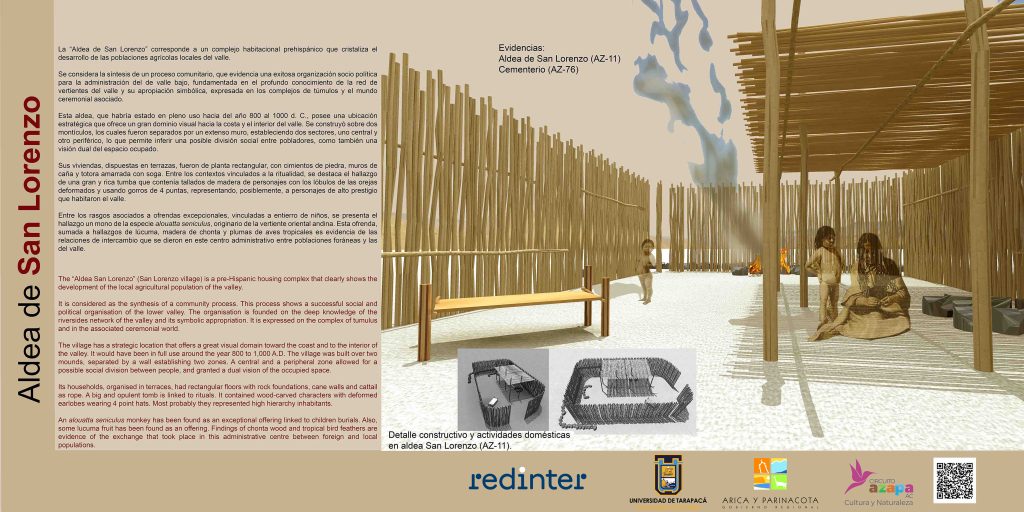Aldea de San Lorenzo (San Lorenzo village)
Aldea de San Lorenzo
Km 12 Ruta A-133, empalme Ruta A-137
(19 K 374992.00 m E 7951561.00 m N)
Evidencias:
-Aldea de San Lorenzo (AZ-11)
-Cementerio prehispánico (AZ-76)
San Lorenzo village
Km 12 Route A-133, splice Route A-137
(19 K 374992.00 m E 7951561.00 m N)
Evidences:
-San Lorenzo village (AZ-11)
– Cemetery (AZ-76)
La “Aldea de San Lorenzo” corresponde a un complejo habitacional prehispánico que cristaliza el desarrollo de las poblaciones agrícolas locales del valle.
Se considera la síntesis de un proceso comunitario, que evidencia una exitosa organización socio política para la administración del valle bajo, fundamentada en el profundo conocimiento de la red de vertientes del valle y su apropiación simbólica, expresada en los complejos de túmulos y el mundo ceremonial asociado.
Esta aldea, que habría estado en uso entre el 500 al 1000 d. C. Posee una ubicación estratégica que ofrece un gran dominio visual hacia la costa y el interior del valle. Se construyó sobre dos montículos, los cuales fueron separados por un extenso muro, estableciendo dos sectores, uno central y otro periférico, lo que permite inferir una posible división social entre pobladores, como también una visión dual del espacio ocupado.
Sus viviendas, dispuestas en terrazas, fueron de planta rectangular, con cimientos de piedra, muros de caña y totora amarrada con soga.
Entre los contextos vinculados a la ritualidad, se destaca el hallazgo de una gran y rica tumba que contenía tallados de madera de personajes con los lóbulos de las orejas deformados y usando gorros de 4 puntas, representando, posiblemente, a personajes de alto prestigio que habitaron el valle.
Entre los rasgos asociados a ofrendas excepcionales, vinculadas al entierro de niños, se presenta el hallazgo de un mono de la especie alouatta seniculus, originario de la vertiente oriental andina. Esta ofrenda, sumada a hallazgos de lúcuma, madera de chonta y plumas de aves tropicales es evidencia de las relaciones de intercambio que se dieron en este centro administrativo entre poblaciones foráneas y las del valle.
The “Aldea San Lorenzo” (San Lorenzo village) is a pre-Hispanic housing complex that clearly shows the development of the local agricultural population of the valley.
It is considered as the synthesis of a community process. This process shows a successful social and political organisation of the lower valley. The organisation is founded on the deep knowledge of the riversides network of the valley and its symbolic appropriation. It is expressed on the complex of tumulus and in the associated ceremonial world.
The village has a strategic location that offers a great visual domain toward the coast and to the interior of the valley. It would have been in full use around the year 800 to 1,000 A.D. The village was built over two mounds, separated by a wall establishing two zones. A central and a peripheral zone allowed for a possible social division between people, and granted a dual vision of the occupied space.
Its households, organised in terraces, had rectangular floors with rock foundations, cane walls and cattail as rope.
A big and opulent tomb is linked to rituals. It contained wood-carved characters with deformed earlobes wearing 4 point hats. Most probably they represented high hierarchy inhabitants.
An alouatta seniculus monkey has been found as an exceptional offering linked to children burials. Also, some lucuma fruit has been found as an offering. Findings of chonta wood and tropical bird feathers are evidence of the exchange that took place in this administrative centre between foreign and local populations.
Its households, organised in terraces, had rectangular floors with rock foundations, cane walls and cattail as rope.
A big and opulent tomb is linked to rituals. It contained wood-carved characters with deformed earlobes wearing 4 point hats. Most probably they represented high hierarchy inhabitants.
An alouatta seniculus monkey has been found as an exceptional offering linked to children burials. Also, some lucuma fruit has been found as an offering. Findings of chonta wood and tropical bird feathers are evidence of the exchange that took place in this administrative centre between foreign and local populations.
